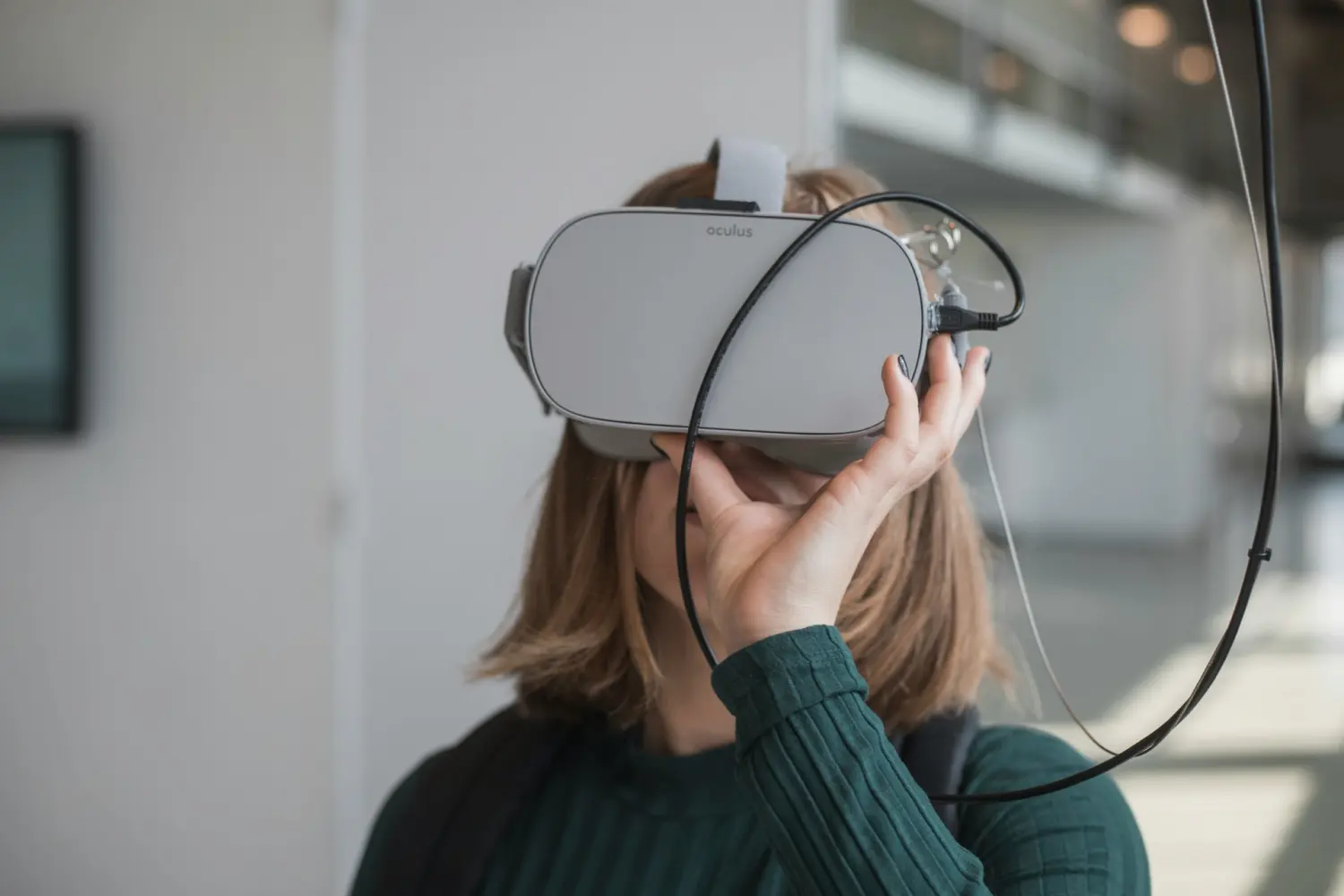Augmented reality (AR) and virtual reality (VR) are two technologies transforming digital interaction. Although they share similarities, they offer very different experiences. On one hand, augmented reality improves the user experience by adding digital elements to the physical world, virtual reality brings users into a virtual environment.
Businesses and individuals often confuse these technologies, but each serves unique purposes. Understanding their differences can help companies choose the right tools for innovation. This article will explain the difference between augmented reality and virtual reality, their benefits, challenges, and practical applications. By the end, you’ll know which technology aligns best with your goals.
Key takeaways
- AR enhances the real world by overlaying digital content, while VR creates a fully simulated virtual environment.
- AR allows real-world interaction, blending physical and digital spaces seamlessly.
- VR focuses on full immersion, replacing real-world surroundings with a virtual world.
- AR is ideal for industries like retail, education, and healthcare, while VR excels in gaming, simulations, and entertainment.
- Both AR and VR improve user experiences, but they require different tools and setups.
What is augmented reality?
Augmented reality provides an upgraded experience by mixing digital elements into one’s real-world surroundings, and works by overlaying visuals, sounds, or other data onto their physical environment. AR works on devices like smartphones, tablets, AR glasses, or headsets that have cameras and sensors.
AR is highly accessible because it requires minimal hardware. Applications like Pokémon GO have made AR popular, demonstrating how users can interact with virtual objects over real spaces. In retail, AR allows customers to preview furniture in their homes using mixed reality before purchasing. For education, AR provides interactive visuals that enhance learning, making complex topics easier to understand.
By connecting digital information to the real world, AR transforms industries, offering improved engagement and user experiences. It bridges the gap between physical tasks and digital innovation, solving real-world challenges in a practical way.
What is virtual reality?

Virtual reality provides a fully immersive experience that replaces the real world with a simulated digital setting, using headsets to block out physical surroundings and place users into a detailed virtual environment.
The VR experience typically involves 3D visuals, audio, and sometimes haptic feedback through controllers, allowing for interaction within the virtual space. This creates an immersive virtual world where users can explore, train, or play. VR is widely used in gaming to deliver lifelike simulations that take entertainment to the next level.
In addition to gaming, VR has practical applications in fields like training and education. Pilots, for instance, use VR simulators for risk-free flight training, while healthcare professionals practice surgeries in a controlled virtual setting. By offering fully immersive environments, VR enables realistic simulations that help industries improve efficiency and safety.
AR vs. VR: Key differences
In the debate of augmented reality vs. virtual reality, each serves different purposes and offers unique experiences. Here are a few examples of areas that AR and VR offer differing experiences.
Level of immersion
- AR: Enhances the real world by adding interactive digital elements without isolating users. Mixed reality allows users to remain aware of their physical surroundings while engaging with digital overlays.
- VR: Provides full immersion by transporting users into a simulated virtual environment. Physical surroundings are replaced with an entirely digital world.
Devices required
- AR: Requires smartphones, tablets, AR glasses, or other devices equipped with cameras and sensors. These tools project digital content onto the real world.
- VR: Requires VR headsets and controllers that block physical surroundings, enabling users to interact fully with the digital virtual world.
Interaction with the environment
- AR: Users interact with both physical and digital elements simultaneously. This is particularly useful for tasks that require real-time assistance or visualization, such as technical training or navigation.
- VR: Interaction occurs entirely within the simulated environment. Users can manipulate objects, explore landscapes, and experience realistic simulations.
Applications
- AR: Best suited for industries like retail, where customers preview products, and healthcare, where surgeons use AR for real-time guidance. Education also benefits from AR through interactive learning tools.
- VR: Ideal for gaming, immersive entertainment, and professional training. Industries like aviation, manufacturing, and sports rely on VR for safe and realistic simulations.
Cost and accessibility
- AR: Generally more affordable and accessible because it uses widely available devices like smartphones and tablets.
- VR: Requires more expensive equipment like headsets and controllers, which limits accessibility for some users.
Benefits and challenges of augmented reality
Augmented reality offers unique advantages across multiple industries. However, it also faces challenges that need to be addressed.
Benefits:
- Improved real-world tasks: AR provides real-time guidance for technical repairs, surgeries, and training, reducing errors and improving efficiency.
- Enhanced customer experiences: AR allows customers to preview products, like furniture or clothing, in their physical spaces. This increases satisfaction and reduces return rates.
- Interactive education: AR brings textbooks and lessons to life by adding digital visuals. Students can interact with 3D models, making learning more engaging and effective.
Challenges:
- Device dependency: AR performance depends on the device's hardware capabilities. Older devices may not support advanced AR features.
- Privacy concerns: AR applications often require access to cameras and sensors, raising privacy and security concerns.
- Limited adoption: While AR has many use cases, its adoption remains slower compared to VR due to a lack of awareness.
Benefits and challenges of virtual reality
Virtual reality provides unmatched immersion but comes with certain limitations.
Benefits:
- Enhanced conversion rates: A recent study showed that the adoption of VR in eCommerce can boost online shopping conversion by up to 17%.
- Immersive entertainment: VR transforms gaming, films, and virtual events by offering lifelike and fully interactive experiences.
- Virtual collaboration: VR allows teams to work together in shared digital spaces, improving productivity for remote projects and training.
Challenges:
- High costs: VR equipment, including headsets and controllers, can be expensive for individuals and businesses.
- Motion sickness: Some users experience nausea or discomfort due to the immersive nature of VR. This limits long-term use.
- Physical isolation: VR blocks out the real world entirely, which can disconnect users from their surroundings during prolonged sessions.
Possible applications of AR and VR

Both AR and VR have practical uses across various industries:
- Retail: AR helps customers visualize products in real-time. VR creates virtual showrooms and immersive shopping experiences.
- Healthcare: AR assists surgeons with 3D overlays during operations, while VR helps train medical professionals in controlled simulations.
- Education: AR makes lessons interactive with 3D content, while VR provides immersive learning experiences like virtual field trips.
- Gaming and entertainment: VR delivers lifelike gaming environments, and AR enhances games with interactive real-world overlays.
How to choose between AR vs. VR for your business
In the debate of augmented reality vs. virtual reality, both are transforming industries by offering unique ways to interact with digital content. AR enhances the physical world with digital overlays, making it ideal for practical applications like retail visualization, education, and healthcare. Its accessibility and affordability allow businesses to integrate it seamlessly into everyday tasks. On the other hand, VR provides fully immersive experiences that replace real-world environments, making it a powerful tool for gaming, training simulations, and virtual events. These technologies cater to different needs, each bringing distinct benefits to the table.
Selecting between AR and VR depends on your objectives. AR is perfect for enhancing real-world interactions with digital tools, while VR excels in creating immersive, simulated environments. By understanding their unique strengths, you can choose the solution that aligns best with your goals. At 3D Source, we’re here to help you harness the potential of these innovative technologies. Contact us today to explore how AR and VR can elevate your business.





